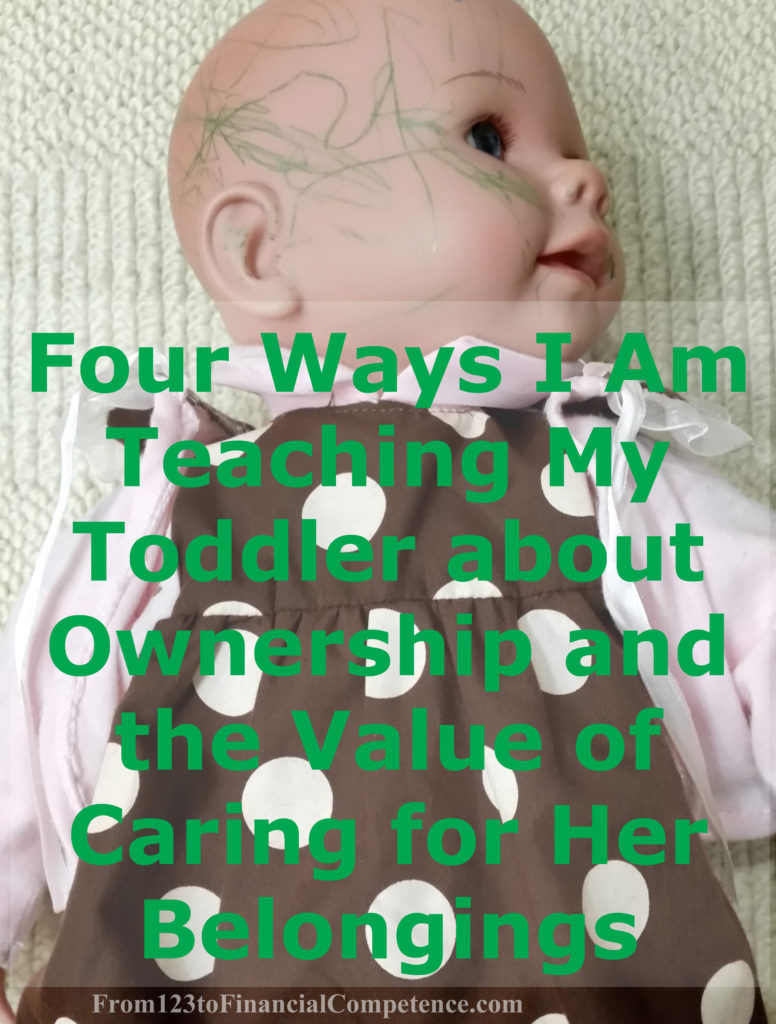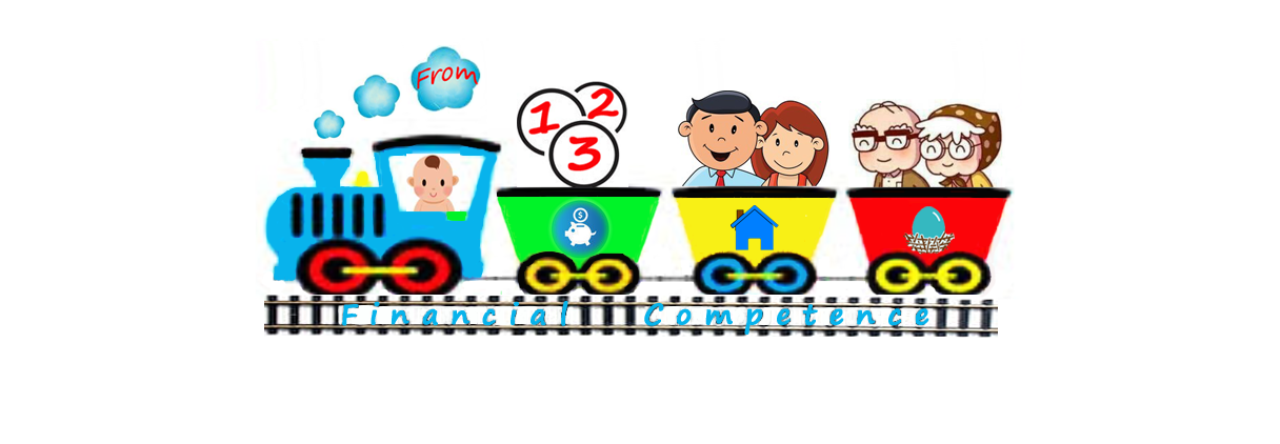Ever wonder what life is like for a young child growing up in a money savvy household?
My husband and I are committed to raising a money savvy child. And we are starting early. At 25-months old, our daughter, Ruby, has limited exposure to money and currency exchange.
Where do we even begin?
How does one go about teaching a toddler about money, saving money and being frugal with money?

My husband and I looked for teaching opportunities. After a few months of careful observations, we saw the need to teach Ruby about the meaning of ownership and respect for property. This form of teaching has many money consequences. Money not spent on replacing objects is money being saved.
Think about how much money parents might spend replacing their children’s broken or lost objects. What about the amount of money adults in the household spend to replace their things due to a child’s carelessness or negligence? My husband’s supervisor has a term for this kind of spending. It’s the “child tax”. And what about the times when a child tears up as he/she takes money out of the piggy bank to buy a replacement item?
In this post, I discuss four approaches my husband and I have been using to teach our daughter about ownership and the value of caring for her belongings. As you read, you’ll notice a pattern in our approaches. We leverage what Ruby already knows and build upon her knowledge base. This way, we can have some confidence that she understands what we’re trying to instill in her.
How It All Began
Five months ago, I walked into the living room and saw Ruby playing in her playpen. She didn’t notice my presence. While standing several feet away, I softly asked, “Ruby, what’re you doing?” She looked up and proudly showed me her art project. She has been coloring Emma’s face with a green crayon!
I took a deep breath. The doll was a gift from her great-grandparents. Ruby noticed the look on my face. It was definitely not the reaction she was expecting. She quickly pushed open the playpen gate, hurried to her books area and started fumbling through the books. She was looking for something. Ah, she found it! With a big smile on her face, she pointed to the cover of a book showing two kids with painted faces. I went down on one knee and gave my daughter a tight squeeze. I was a proud mama. I was a frustrated mama at the same time.
The following day, I was ready to have a discussion with my husband. We came up with about 10 random things we wanted to try. The four approaches below reflect those we’ve found work best for my family. We continue to modify them as we learn more about our daughter.
The approaches aren’t in any hierarchical order. Some situations allow my husband and I to implement two or more together. From our experiences, it’s more effective doing it this way. As you will read, the four approaches are all interrelated and they work well with each other.
Approaches
Use Possessive Pronouns to Teach Ownership
At 18-months-old, Ruby developed some understanding of possessive pronounces. She knew which shoes, pieces of jewelry, bags, cups, toothbrush and keys belong to her mama. She would say, “baba coffee, baba computer, baba shoes, baba keys, baba clothes, etc. She also knew her name. Any reference to baby was about her. She would point to cartoon baby illustrations (e.g., the baby froggy and her mommy) and repeatedly said “Ruby, Ruby”.
Leveraging on her language skill, my husband and I help her make associations between her name and her belongings. We would say, “This is Ruby’s crayon” and “That’s Ruby’s bowl”. We also emphasize on the possessive pronouns, “your” and “yours”. For instance, we would say, “Ruby, this is your backpack”.
Through repetitive association, Ruby quickly learns which objects in the household belong to her. She knows which drawer to open to pick out her clothes when it’s bath time. As we are getting ready to leave the house, she knows which hat is hers and which is mama’s. She would put on her shoes and then proceeds to pick out my shoes for me.
At 25-months old, my husband and I are confident our daughter has mastered possessive pronouns. We don’t have enough information to know if she understands she’s in charge of her belongings. However, we’ve observed that she has been more gentle with her toys and books (though not consistent). And for now, this is good enough for us. We hope in time Ruby will come to understand she’s in charge of her belongings. It would be in her best interest to take good care of them. One way to accumulate wealth is taking care of your belongings.
Designate a Place for Specific Things and Activities
My daughter has the tendency to misplace things. Prior to implementing this strategy, a box of crayons would disappear within a week. Pieces of a puzzle set would disappear one by one. For some time, I struggled. On the one hand, I wanted Ruby to take an active role in her learning. Having materials locked up or packed away won’t accomplish that. On the other hand, I didn’t want to spend more time than I wanted fetching for missing objects all over the house. Where’s the letter “B” block when I wanted to show her the spelling of her name?
After much discussion with my husband, we created a station for her soft toys, one for reading, one for arts and crafts, one for writing and another for doing math. Our hope is that even when pieces of crayon are laying all over the floor, at least we wouldn’t have to search far and wide to find the complete set.
We’ve been working with her on this for almost four months now. The situation is not perfect. Things still go missing. However, Ruby appreciates having this structure in place. She knows what to expect when we sit down by a certain station. Frequently, she asks to move to another station during the cleanup process. I like to think she has some understanding that certain things belong to certain places.
This strategy has been working well for my family. We spend less time fetching things. My husband and I feel less frustrated with our daughter. Ruby has more things to play with and for longer periods of time (this is hard to accomplish when things keep disappearing!). In my household, having things last longer is one way of being money savvy. Money not spent replacing things is money being saved.
Use Before and After Pictures to Help Her Remember
My daughter loves taking and looking at pictures. In fact, “picture” is one of her favorite words. My husband and I encourage her to take pictures of her belongings. This happens each time we introduce something new to her collection of things. And we set time aside for her to take pictures every weekend. Then, I put pictures of the same object into collages. This sequence of activity allows my daughter to see the history of her belongings.
As my husband and I show her the collages, we explain to her that the object used to be a certain way, and now it’s broken and/or dirty. “Broken” is also one of her favorite words. It’s always interesting looking at her facial expressions as we move from one picture to another. We think she gets our message. She would point to a picture and excitedly says, “broken ah, broken ah!”
She still breaks and ruins things, but to a much lesser degree. Sometimes she would begin to tear a page on a book while looking at me or her daddy. She’s aware she’s doing something she’s not supposed to do. Many months lie ahead before she masters her motor skills. Her cognitive abilities will take many more years. We’ve been seeing progress though. And that’s what matters to us.
Don’t Replace Broken or Lost Objects
The first time I noticed the turn dial on Ruby’s musical lamb came loose, I rushed out and got her a replacement. The lamb was a favorite of hers. In less than two weeks later, the turn dial on the new lamb broke. When we got the replacement, my husband and I showed Ruby how to turn the dial. We instructed her to be gentle with the lamb. We explained to her that the toy costs money and that mommy had to leave the house to get her a new one.
None of that seemed to work. Sometimes Ruby would crank up the dial with such strong force, meanwhile making eye contacts with me and smiling big. Asking her to stop only had her crank up the dial even harder.
After that incident, my husband and I decided it was time to teach Ruby a hard lesson. We no longer replace Ruby’s broken or lost objects when those objects aren’t essential for learning or growth. When a puzzle piece was missing, we didn’t throw away the puzzle set. We wanted the puzzle to serve as a remind to Ruby that the missing piece is a consequence of an action she did earlier. We wanted to use this opportunity to show her that when things aren’t cared for properly, she will no longer have those things.
Ruby notices the missing puzzle piece each time we take out the puzzle set. She would point to the empty space, make eye contacts with me or her daddy and ask, “Where is it?” And each time, we would tell her, “This is what happened when you neglected to take care of your belongings. Do you remember where you put the Elephant?” Ruby would get up, go by all corners of the house where she likes to hang out, messily fumble through her things and come back and report, “No more.”
Once a while, we would see sadness on her face. As my husband and I continue to speak with her about the missing puzzle piece and ask her questions (we try to help her recall), sometimes we would see a slight hint of guilt. Moments like these offer us some hints into her mind and indirectly inform us on how we’ve been doing.
******
I haven’t have much luck finding published materials on toddlers and money. A number of articles have been written on preschoolers. My husband and I will continue to work hard and be creative with our parenting strategies. We are witnessing what years of being financially savvy can do for us. Financial freedom is worth the effort.
The next time you break or lose something and feel the strong urge to get a replacement, ask yourself if you really need the item. Can you do without or improvise? Do you have an old one you can use? Do you have the cash to pay for it? Can you afford it? Can you wait for a sale? Remember, money not spent is money being saved toward a financial goal.


Comments are closed.